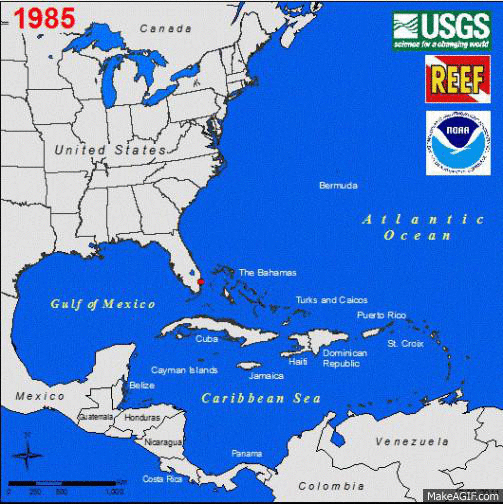What to do with a species that doesn't belong, spreads like wildfire and causes damage to native ecosystems?
Some are suggesting take down by knife and fork.
The idea, termed “invasivorism,” is becoming an increasingly popular strategy to control invasive species. But after speaking to experts and many invasivores, it's clear that this approach is limitied. Chefs have to be able to acquire the invasive easily and make it delicious enough for people to want to eat. Yet there is at least one species that invasivores, experts and chefs deem a serious contender for control by consumption… the lionfish.
Lionfish aren't native to the waters of the Western Atlantic, Caribbean and Gulf of Mexico, where they are now taking over, reducing native marine species by an average of 65 percent. Originally from the Indo-Pacific, the striped psychedelic-looking invader was first spotted in 1985, off the southeast coast of Florida, where citizens reportedly dumped their unwanted pets. The situation has since changed dramatically:

“We're finding them as shallow as inches and as deep as a thousand feet,” said Lad Akins, Director of Special Projects at Reef Environmental Education Foundation (REEF) who has led the charge in battling the invasion, organizing lionfish derbies and co-authoring a cookbook. “Determining just how many are out there is not within our realm — for certain it is many millions.”
And each one of these millions of fish is perfectly designed for ecosystem takeover. Equipped with 18 sharp, venomous spines, the fish has no known predators. Capable of reproducing every three to four days for the entire year, a single female lionfish can spawn upwards of 2 million eggs annually. With no concept of portion control (they've been caught eating eating more than 1,000 pounds of prey per acre per year in the Bahamas), they seem more vacuum than vertebrae. “Lionfish are gluttonous predators: They will eat anything that moves and fits into their mouth, sometimes larger than half their own body size,” Akins said. This includes native species such as snapper and grouper, vital for local economies, as well as small reef dwellers that maintain stability in these delicate reef ecosystems. “There just may not be a lot left after lionfish have run their course,” Akins said.
Experts are predicting the worst when it comes to the impact on these important habitats. “The coral reefs are like our Yellowstone in the sea,” said James Morris, an ecologist at the National Centers for Coastal Ocean Science and one of the National Oceanic and Atmospheric Administration's (NOAA) premiere lionfish experts. “Now we have an invasive species that's threatening the integrity of these valuable natural resources — it's really hard to translate that into economic dollars.” What's worse, Morris noted, is that the invasion hasn't yet peaked. And if we don't get the populations under control, the damage will be irreversible.
“Complete elimination is no longer an option,” Morris said. In a recent study, he estimated that more than a quarter of adult lionfish would have to be removed every month in order for the population to decrease. “Now, this is really about triage.”

To date, plenty of management strategies exist. Morris works closely with conservation area managers to develop sustainable removal plans. Additionally, scientists throughout the invaded region are figuring out the largest number of lionfish that can inhabitat a particular area for recovery of the native ecosystem. When lionfish were removed to these “threshold densities,” these researchers found a 50 to 70 percent increase in the biomass of the native fish eaten by lionfish. Derbies offering cash for capture, like the ones organized by Akins of REEF, have proven extremely successful in their efforts. And individuals, equipped with spears, have made lionfish hunting a popular sport.
Yet sustaining these removal efforts is the issue. Lionfish aren't an easy catch, and hard work requires incentive. “This is not your ordinary run-of-the-mill fish that you can collect in large numbers,” Akins said. “Divers have to go out there and catch them individually with spears or nets.” In order to clean the reefs of these invasive species, Akins and others are supporting harvesting the fish for food. “The commercial fishing industry is one of the best ways of controlling lionfish for the long term," Morris said.
Control by consumption is already proving successful. Jamaica's National Environment and Planning Agency recently reported a 66 percent drop in lionfish sightings — mainly attributed to the growing demand for lionfish fillets. “The fact is, they've been consumed in their native range forever,” Akins said. “This isn't a trash fish that nobody wants which is a really good thing because if they weren't delicious we'd be in serious trouble.”
Prodded by scientists, conservationists and fearless foodies, the restaurant industry is starting to catch on. “It's good for us, it's good for you, it's good for the environment and it's delicious,” said Ryan Chadwick, owner of Norman's Cay, the only restaurant in New York City currently serving lionfish.
For diners unfamiliar with the invasive, restaurants turn a profit through an educational message promoting sustainability. Castaway Waterfront Restaurant and Sushi Bar (Marathon, Fla.) has stickers all over reading: “Save the Reef, Eat a Lionfish.” At Chef Michael's (Islamorada, Fla.), where tourists are abundant, the chef prepares little fritters for sampling accompanied by a message that choosing lionfish can help save the reef. “I tell people it's yummalicious and give them a sample,” noted the chef, Michael Ledwith. Ledwith and other chefs' strategy to expand our palates seems to be working. “We run out whenever we have it,” Ledwith added.
These restaurants are just a few among the many — depicted in the map below — that have begun to serve the fish. The restaurants featured in this map were first identified from lists composed by REEF and the World Lionfish Hunters Association (WHLA). I then called each establishment from those lists to confirm (or deny) that lionfish is served. Through follow-up questioning and networking, I found places unidentified by either REEF or WHLA. The map below is thus the most comprehensive and up-to-date list of restaurants that serve lionfish in the United States. Click around to explore different trends such as when lionfish first invaded a menu, whether it's a menu staple or restaurant special, the different methods restaurants use to get the fish, how it's prepared and how much it costs.Lionfish are an invasive species perfect for mass-consumption: abundant, unregulated, easily-acquirable (if given proper incentive) and sufficiently tasty for chefs to want to prepare and people to get over their fears and order. Both Akins and Morris couldn't be happier. “This is a great opportunity for everyone to be a part of a long-lasting effort to help get lionfish out of the water,” Akins said. “People are getting educated and accustomed to this idea and frankly, harvesting lionfish is our only option,” Morris agreed.
Lionfish provide a compelling example of an invasive species fit for consumption, but it's not the only one showing up in restaurants around the country. I've started to compile a list of restaurants serving other invasives, which I will soon add to the map. In addition, I've decided to loosen the reigns and open the map for public contribution. I'm hopeful that together, we can create the most comprehensive map possible. If you're a chef, supplier, foodie or even remotely interested in this movement please add a place where you've seen an invasive on the menu (or as a special), or tried one for yourself. I hope this can become a growing project to spread the word and employ our appetites as one method of invasive species control.